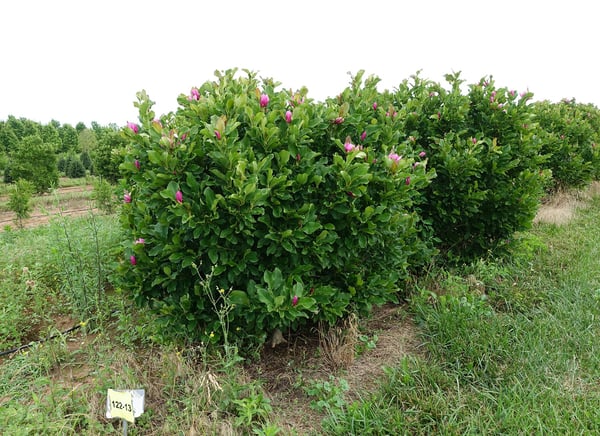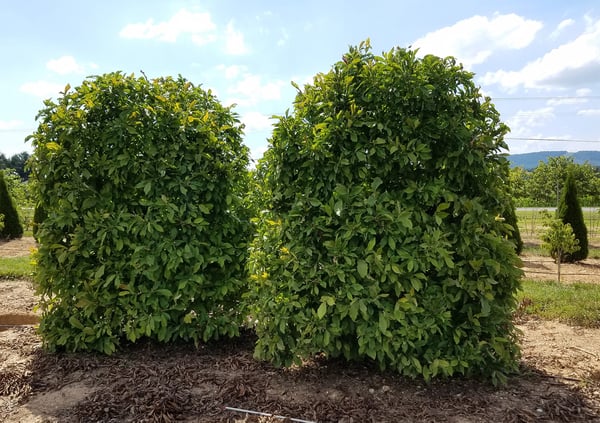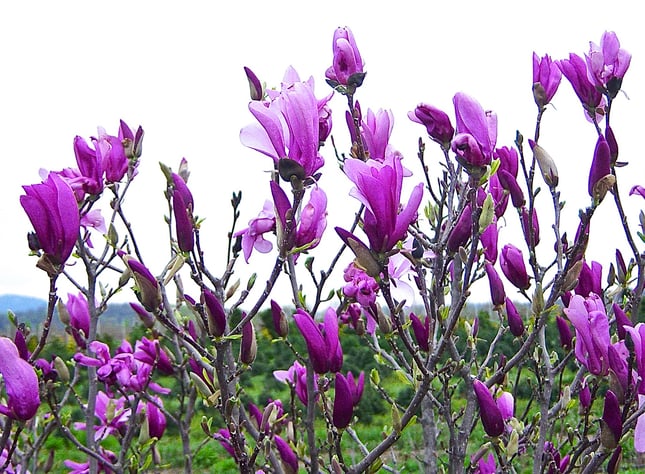Flowering trees that can liven up your garden in spring with brilliant flowers are always in high demand. The good news is that the genus Magnolia contains about 100 species (including hybrid cultivars) of deciduous and evergreen trees to choose from. Almost all feature large simple leaves and showy (sometimes fragrant) flowers that bloom in the early spring, but there are a few specialty cultivars that stand out.
Two of our favorite Magnolias are ‘Ann’ and ‘Betty.’ They come from the Little Girl series developed in the mid-1960s by Francis DeVos and William Kosar who crossed Magnolia liliiflora with Magnolia stellata. These two hybrid Magnolias are best known for having a compact, shrubby habit and producing large, red-purple flowers. They were designed to bloom later to avoid possible frost damage. They also tolerate air pollution, making them solid choices for urban areas
So, what do we love so much about the ‘Ann’ and ‘Betty’ Little Girl Magnolias?
Magnolia ‘Ann’
 If you’re looking for a compact and shrubby tree with fragrant purple-red flowers that bloom early and open wide, the Magnolia ‘Ann’ is a great choice.
If you’re looking for a compact and shrubby tree with fragrant purple-red flowers that bloom early and open wide, the Magnolia ‘Ann’ is a great choice.
- Plant Type: Deciduous Shrub
- Zones: 4 - 7
- Height: 8 - 10 feet
- Spread: 8 - 10 feet
- Colors: Bright green leaves with purplish-red flowers
- Light: Full sun to partial shade
- Water: Medium
- Uses: Shrub borders, woodland peripheries, mass planting, specimen planting
- Benefits: Clay soil tolerant, spring bloomer, showy and fragrant flowers
This Little Girl Magnolia, introduced by The National Arboretum in 1965, is best-known for its upright and erect deep purple-red flowers. Like all eight Magnolias in the series (Ann, Betty, Jane, Judy, Pinkie, Randy, Ricki, and Susan), it blooms about 2-4 weeks later than the standard Magnolia tree, which means it has a reduced risk of occurring damage during a late spring frost. This makes it an excellent flowering shrub for lawns and landscapes of all types.
The Magnolia ‘Ann’ is primarily recognized for its compact shrubby habit that grows slowly. Over time, it may reach 10-12 feet in height and width, and with that you’ll enjoy chalice-shaped flowers that open to 4 inches wide in the spring. Flowers may also sporadically repeat bloom in the mid-summer before the shrub’s medium green leaves turn yellow in the fall.
Noteworthy Characteristics
Best grown in organically rich, neutral, and slightly acidic soil, the Magnolia ‘Ann’ is a medium-maintenance cultivar that is heavily location dependent. It appreciates root-zone mulch to retain soil moisture while still being well-drained. It also survives best in locations that are protected from strong winds and warm southern exposure. And once planted, it should not be moved as it can easily take damage during transplanting.
Potential disease problems can include leaf spots, anthracnose, canker, dieback, and powdery mildew. It is also susceptible to weevils, snails, scale, and thrips. So, it is best used in landscapes where regular maintenance is acceptable. The good news is that little pruning is required beyond the removal of dead or damaged branches immediately after flowering.
Alternate Cultivar: Magnolia ‘Betty’
 And if you need a Little Girl Magnolia that grows more vigorously and reaches a larger spread, the ‘Betty’ cultivar is another excellent choice.
And if you need a Little Girl Magnolia that grows more vigorously and reaches a larger spread, the ‘Betty’ cultivar is another excellent choice.
- Plant Type: Deciduous Shrub
- Zones: 4 – 7
- Height: 12 - 15 feet
- Spread: 8 - 10 feet
- Colors: Bright green leaves with red-purple flowers and a white interior
- Light: Full sun to partial shade
- Water: Medium
- Uses: Tall shrub borders, woodland peripheries, mass planting, specimen planting
- Benefits: Clay soil tolerant, spring bloomer, showy and fragrant flowers,
‘Betty’ differs from ‘Ann’ in a few key areas. It is a faster-growing Magnolia that reaches heights of 15 feet and produces extremely large flowers up to 8 inches in diameter. These red-purple flowers bloom slightly later in the spring (mid to late April) than ‘Ann’ and do not open quite as wide, remaining in more of a cup shape. The flowers also have a white interior and bloom shortly before foliage begins to appear.
Purple-Red Flowers in the Spring
When you need a beautiful tree-like shrub that produces vibrant purple-red blooms in the spring, you can’t go wrong with either ‘Ann’ or ‘Betty’ Magnolia cultivars. Their blossoms are large, slightly fragrant, and deep in color, making them beautiful specimens for almost any landscape. You really can’t go wrong with a Little Girl Magnolia. After all, it took ten years of breeding to make them the beautiful and functional cultivar they are today.





